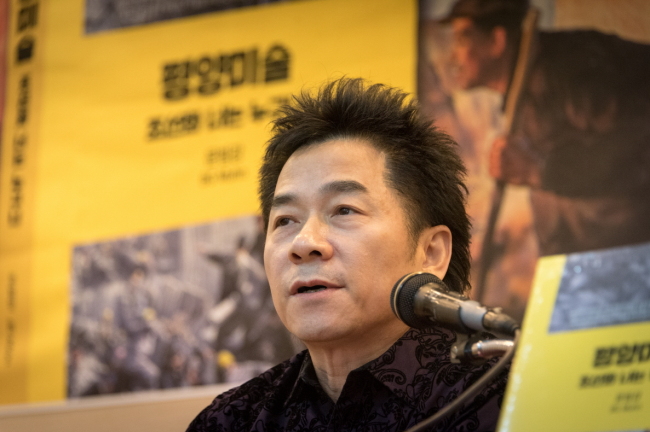‘When people ask whether I am liberal or conservative, I tell them that I am an artist,’ said Muhn Baum-gong, also known as BG Muhn, an artist and professor at Georgetown University, during a press conference in Seoul on Wednesday to promote his latest publication “Pyongyang Art: The Uncovering the Complex Layers of Chosonhwa.”
Dispelling any possible suspicions concerning his ideological orientation and possible ties to North Korea, Muhn emphasized that North Korean art deserves due attention from the outside world, apart from the political elements associated with them.
 |
BG Muhn, an artist and professor at Georgetown University, speaks at a press conference in Seoul on Wednesday. (Seoul Selection) |
“I, too, was somewhat afraid of facing images portrayed by North Korea because I received anti-communist education back in the past,” Muhn said.
Things changed dramatically in 2010, when he encountered an extraordinary piece of “Chosonwha” -- one of North Korea’s main art genres -- through an art dealer in Washington, Muhn recalled. “I had to step back first when I first saw that North Korean painting -- largely due to the educated fear against the communist country -- but at the same time, (I was) shocked by the poetic and lyrical qualities it carried,” said Muhn.
Drawn by the encounter with that painting and intellectually intrigued by North Korean art, Muhn began to delve into North Korean art that not many outsiders have access to. Since 2011, Muhn has visited North Korea nine times to conduct field research and to interview artists, museum officials, art historians and art school faculty members, all, of course, accompanied by minders and guides.
“Pyongyang Art: Uncovering the Complex Layers of Chosonhwa” is a result of Muhn’s six years of research dedicated to shedding light on North Korean art.
“What they first did when I arrived at North Korea was to take my passport away from me. From that moment, I was totally in the hands of the guides and the minders,” said Muhn.
“It took time to earn the trust of the art associates in North Korea,” he added.
“Every time I visited, I felt I had not completed enough research, and that pushed me to visit the country nine times.”
While admitting that North Korean art is also used as a means to propagandize the regime and its ideology, Muhn argued that North Korean art requires a new perspective, apart from the ideological elements attached to them.
 |
“The Miracle of Chongchon River” painted by six North Korean artists (Seoul Selection) |
“People often have this stereotype of North Korean art as being the same. I used to think that way as well before I started my research. North Korean paintings have (stylistic) diversities,” Muhn said.
He will also curate a North Korean art exhibition during the upcoming Gwangju Biennale, which is slated to start on Sept. 7. During the biennale, Muhn will introduce some 22 paintings from North Korea, including some five large painting works -- measuring some five-meters in width -- created by multiple painters. Some of these large paintings are direct portrayals of the regime’s ideological triumph and could possibly offend some viewers.
“I think one shouldn’t feel afraid of the ideological difference. (I believe), we are at a point, where we can accept such differences,” Muhn said.
Muhn and the Gwangju Biennale are waiting for the Unification Ministry’s approval of the list of works that will be exhibited.
By Shim Woo-hyun (
ws@heraldcorp.com)






![[Exclusive] Hyundai Mobis eyes closer ties with BYD](http://res.heraldm.com/phpwas/restmb_idxmake.php?idx=644&simg=/content/image/2024/11/25/20241125050044_0.jpg)
![[Herald Review] 'Gangnam B-Side' combines social realism with masterful suspense, performance](http://res.heraldm.com/phpwas/restmb_idxmake.php?idx=644&simg=/content/image/2024/11/25/20241125050072_0.jpg)

